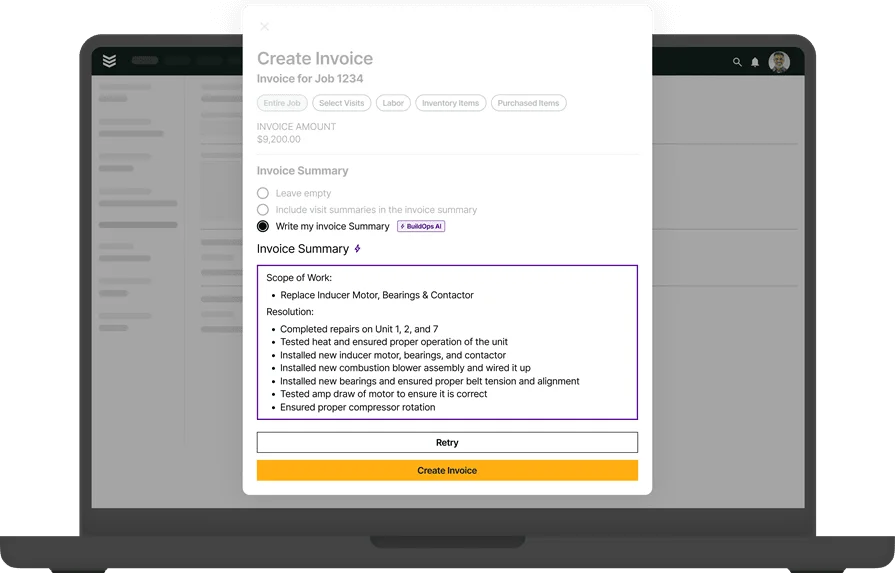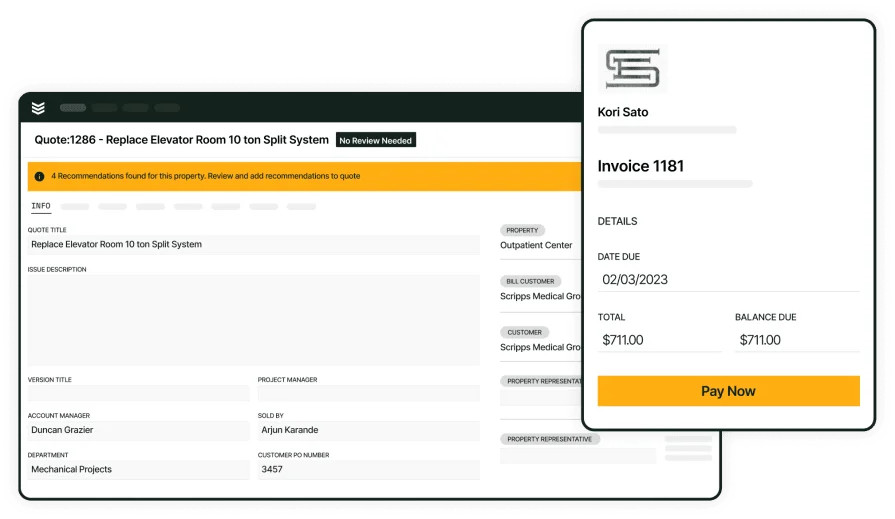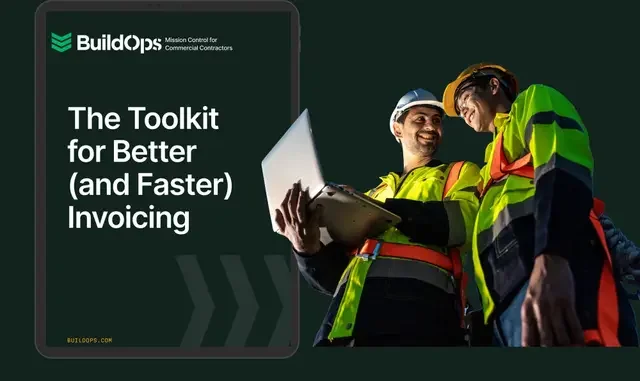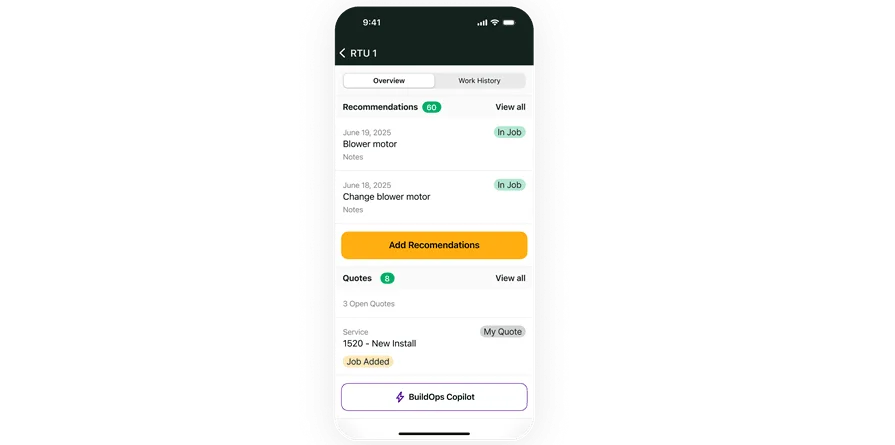Keeping jobs straight takes work—quotes change, approvals get missed, and payment delays eat into margins. One bad invoice or a half-finished estimate can cost a contractor real money. A solid contractor estimate and invoice app puts everything in one place. It connects quotes to jobs and invoices without the back-and-forth. Field crews know exactly what was approved, what needs billing, and where the numbers stand.
Contractors managing field teams know the value of clean workflows. From initial quote to final invoice, the smoother the handoff, the faster you get paid. These apps take the guesswork out of the process, especially when jobs shift by the hour. For teams focused on staying sharp in the field, using a connected system that ties together quoting, billing, and job progress has become part of standard field service management setups. This breakdown covers:
- Why contractor estimate and invoice apps matter on every job
- What to consider before choosing your next estimate and invoice app
- 6 key features contractors actually need in their estimate and invoice tools
- 6 best estimate and invoice apps for contractors
- 7 benefits of using estimate & invoice apps for contractors
- 4 important FAQs answered about estimate and invoice apps
Let’s start with what makes these tools essential—especially when deadlines are tight and every dollar counts.
Why contractor estimate and invoice apps matter on every job
Every project starts with two things: a price and a promise. You tell the client what it’ll take, and they expect you to stick to it. But when estimates sit in spreadsheets and invoices go out days later—or worse, fall through the cracks—that promise starts to slip.
A contractor estimate and invoice app keeps both field and office teams aligned. Techs in the field can track labor, log changes, and update scopes as they happen. Meanwhile, the office team sees it all in real time—no missing paperwork, no guessing what needs to be billed.
This kind of setup gives contractors control over quotes, approvals, and invoicing in one flow. It also creates a shared record between the jobsite and the back office—so the numbers stay tight and the billing stays accurate.
For a deeper breakdown of how these tools handle estimates and billing in the field, this overview of contractor estimate and invoice apps lays out what’s working across the industry and where most teams see the biggest gains.
What to consider before choosing your next estimate and invoice app
Contractors in the field rely on clear schedules and tight handoffs. When an estimate gets approved but doesn’t show up on the jobsite—or when invoices get delayed because no one knows the latest scope—it hits your time and your pay. Choosing a contractor estimate and invoice app means finding a tool that can keep up with fast-moving crews, shifting job details, and real-time billing decisions.
The best apps aren’t just about sending invoices. They help your field and office teams stay aligned—from the first quote to the final payment. If you’re weighing your next platform, make sure it actually fits how your team works day to day. Start with these five questions:
- Workflow fit – Can it keep estimates, approvals, and billing in sync without re-entering the same details? Does it connect quotes to materials, labor, and field activity in a way that matches how your crews already get jobs done? Can it adjust when change orders or last-minute updates hit the schedule?
- Ease of use – Can your foreman figure it out in five minutes without calling support? Does it work from a phone on the jobsite, in the truck, or back at the office? Can your team send out quotes or invoices right after the job wraps?
- Reliability under pressure – If something breaks, can you reach someone who understands field work? Does the app stay stable when things get busy—or freeze up when you need it most?
- Scalability – Will it still work when you go from 10 jobs to 40? Can it handle multiple job types, subcontractor billing, and partial invoices without needing bolt-ons? Or does it max out the minute your business steps up?
- Features – Can it break down labor and materials by trade? Does it flag markup and track costs by job? Can you create accurate pay apps and keep tabs on what’s been billed, what’s pending, and what still needs action—without digging through stacks of paper?
Once you’ve got answers to these, you can start zeroing in on the tools that actually help in the field and give the back office what it needs to keep billing accurate and cash flowing.
6 key features contractors actually need in their estimate and invoice tools
A contractor estimate and invoice app does more than push paperwork. It connects field activity to billing with features that reflect how real jobs unfold—from change orders and same-day work to split invoices and material costs. For contractors handling field crews, the app should support how teams quote, perform, and collect—without slowing down the jobsite or the office. Below are six must-have features that help keep jobs on track and cash flowing.
1. Field-ready scheduling and dispatching
Every job starts with knowing where your techs are going and when they’ll be there. A strong contractor estimate and invoice app should work seamlessly with both field service scheduling and dispatch software to ensure quotes turn into completed work—fast. Let’s say a same-day service call gets bumped up to priority. The scheduler reassigns the closest available tech, the estimate updates, and the dispatch pushes straight to their phone. The job gets done without back-and-forth calls or missed steps, and the invoice goes out before the truck leaves the site.
2. Mobile access for techs on every job
An estimate that never makes it to the field doesn’t get approved—and work that doesn’t get logged never gets billed. A technician mobile app gives crews full access to estimates, invoices, and job details without needing to call in or head back to the office. For example, out on a rooftop HVAC repair, your tech spots a failing motor outside the original scope. Instead of jotting it down for later, they update the estimate on the spot, get sign-off from the customer, and send the invoice before climbing down the ladder.
3. Built-in payment collection
Once a job wraps, you should be able to collect payment—without delay. A payment-ready tool inside the estimate and invoice app helps close the loop fast. Whether it’s deposits, card payments, or final balances, everything flows through one system. Say a multi-phase job wraps just before a long weekend. The tech confirms completion in the app and takes payment from the customer right there in the driveway. The office sees the cleared payment instantly and moves on to the next job without follow-up calls.
4. CRM built for contractors
Tracking leads, quotes, and client history all in one place keeps teams aligned. A CRM tool connected to your estimate and invoice app ties together contact records, job details, and service history without extra tools. For instance, a service manager gets a call from a property manager asking for a quick estimate. Instead of starting from scratch, they pull up the last approved quote, duplicate it, and send the updated version within minutes—no guesswork, no delays.
5. Job costing and pipeline visibility
Knowing what’s been quoted, what’s approved, and what’s still open gives contractors a clear path to payment. A connected job pipeline helps estimate and invoice apps turn field activity into cash with fewer missed items. Consider this: On a busy Wednesday, your ops lead opens the pipeline and sees that two jobs need time entries, one invoice is still in draft, and another just got approved for billing. Instead of sorting through emails or texts, they know exactly what to push next to keep the billing cycle moving.
6. Time tracking that ties directly to labor costs
Labor gets expensive fast—especially when hours go untracked. A time tracking system inside the contractor estimate and invoice app gives you full visibility on job costs and labor hours in real time. Imagine, during a facility maintenance job, two techs log extended hours across three visits. Their time syncs automatically into the job record, and the final invoice reflects the actual labor without manual entry. No missed hours, no billing delays.

Explore our invoicing product
Don’t just speed up job timelines, make sure payments are always on time too.
Other notable features for contractors to look for
While the core features carry the biggest weight in choosing a contractor estimate and invoice app, there are a few extras that can boost visibility, reduce manual steps, and help keep your business tighter as it scales. These tools aren’t always the first thing you look for—but when they’re included, they add serious value.
- Service agreement tracking – If you handle recurring work or maintenance contracts, having service agreement tools built in helps you stay ahead of renewals, track what's been completed, and bill correctly against the scope.
- Fleet visibility – Knowing where your trucks are, who’s on the road, and what’s assigned to each vehicle can keep jobs moving without delay. A connected fleet management system helps sync field activity with job dispatch and quoting.
- Reporting and insights – A strong reporting dashboard inside your estimate and invoice app can give your team a clear picture of outstanding quotes, open invoices, and average time to payment. This helps you make faster decisions without waiting for weekly check-ins.
Now that you’ve seen what features actually move the needle—both the must-haves and the nice-to-haves—it’s time to look at the tools that deliver. The best contractor estimate and invoice app isn’t just about checking boxes. It’s about how well those features show up in the field, support your techs, and keep jobs billable without extra steps. Let’s break down six top options contractors are using today.
6 best estimate and invoice apps for contractors
Choosing the best contractor estimate and invoice app depends on the type of work you take on, how your team operates in the field, and how much flexibility you need between quoting, scheduling, and billing. Some apps are tailored for complex commercial workflows. Others keep it simple for quick jobs and small teams. The key is picking a tool that fits how your crew works—not one that adds more to your plate.
1. Best for commercial contractors: BuildOps
BuildOps gives commercial contractors a full system for quoting, scheduling, invoicing, and job tracking—all under one roof. It’s built for field-heavy operations where teams are juggling multiple jobs, scopes, and service lines. Everything connects—from the moment a quote goes out to the minute an invoice gets paid. Teams in the field and office stay on the same page, whether they’re managing multi-site jobs or recurring maintenance work.
How Pricing Works: BuildOps offers customized pricing based on team size, workflows, and the tools you need. Quotes are tailored to the way your business runs.
Features Beyond Invoicing: Includes dispatch, technician time logs, contract management, service history, and job coordination—all designed to support commercial-scale operations.
What Sets It Apart for Commercial Contractors: BuildOps is purpose-built for commercial contractors needing scope control, large-volume service billing, and tight field-office integration across crews and jobs.

Curious to see it in action?
BuildOps helps teams tighten their process from bid to billing so you get paid fast.
2. Best for residential contractors: Housecall Pro
Image Source: Housecall Pro
Housecall Pro is built for residential service pros who want a fast, mobile-friendly app for estimating, booking, and invoicing. It’s easy to set up and works well for solo contractors or small teams handling service calls, punch lists, and small installs. With everything packed into one interface, even new users can get up and running without a learning curve. It may not be the best fit for contractors managing complex jobs, change orders, or anything involving phased billing or large crews.
How Pricing Works: Monthly pricing adjusts based on your crew size and access needs, with starter plans for individuals or smaller teams.
Features Beyond Invoicing: Expect automated texts and emails, customer management, payment collection, and scheduling tools designed to speed up residential workflows.
What Sets It Apart for Residential Contractors: It keeps things simple and moves fast—ideal for home service jobs that need quick turnaround, quick pay, and minimal admin overhead.
3. Best for general subcontractors: Joist
Image Source: Joist
Joist is a solid pick for subcontractors handling repairs, upgrades, and renovation work. It brings together estimates, invoices, and payments in one mobile dashboard that’s easy to learn and use on-site. With drag-and-drop estimates and job templates, it’s a fast way to send bids, collect signatures, and close jobs without needing a desktop. That said, Joist may fall short for contractors who rely on service agreements, scheduling tools, or advanced job costing tied to field crew hours.
How Pricing Works: Starting at $129/month for up to five users. Costs scale depending on features and user volume.
Features Beyond Invoicing: Includes payment alerts, job tracking, customer communication, and simple scheduling support for daily job needs.
What Sets It Apart for General Subcontractors: Joist is ideal for smaller jobs that need fast turnaround. It avoids over-complicated tools and focuses on keeping quotes, payments, and client records organized and accessible.
4. Best for small service contractors: Jobber
Image Source: Jobber
Jobber is built for service contractors handling repeat calls, repairs, and maintenance jobs. The app helps teams send estimates, schedule jobs, and invoice without switching between tools. Jobber’s interface is simple enough for techs in the field, but it also gives the back office visibility into what’s been quoted, approved, and paid. For smaller teams handling steady workflows, it keeps things moving. Jobber may lack some of the depth needed for larger contractors, especially those managing multi-phase jobs or working with complex service agreements.
How Pricing Works: Monthly plans start at $25 for single users, with higher tiers based on user count and features.
Features Beyond Invoicing: Includes scheduling, batch invoicing, overdue alerts, and real-time customer communication tools—all designed to keep jobs moving without backlogs.
What Sets It Apart for Small Service Contractors: Jobber focuses on keeping your pipeline clean and simple. Great for contractors who want fast quotes, clean billing, and solid tracking without extra overhead.
5. Best for solo contractors: Invoice2go
Image Source: Invoice2go
Invoice2go is a lightweight tool that helps independent contractors send estimates, create invoices, and collect payments—all from their phone. Its simple interface is easy to navigate, with customizable templates and fast setup. For solo operators working directly with clients, it keeps everything organized without needing complex systems. However, Invoice2go may fall short for contractors who need team collaboration, job scheduling, or integration with dispatch and field management tools.
How Pricing Works: Monthly plans start with basic features and scale based on document volume and feature access.
Features Beyond Invoicing: Offers branded quotes and invoices, expense tracking, automatic payment reminders, and real-time status updates.
What Sets It Apart for Solo Contractors: Invoice2go gives self-employed pros a clean way to manage quotes and payments from the jobsite or the truck—no spreadsheets or desktop tools required.
6. Best for specialty contractors: ServiceTitan
Image Source: ServiceTitan
ServiceTitan caters to specialty contractors in fields like HVAC, plumbing, and electrical. It’s built to manage field techs, pricing, quotes, and billing for service-heavy businesses. ServiceTitan’s strength lies in its ability to standardize how work gets quoted and billed—so contractors can avoid revenue loss and keep margins tight. It’s a powerful platform with deeper tools for high-volume or multi-location teams. That complexity may be overkill for smaller operations that don’t need enterprise-level tools or integrations.
How Pricing Works: Custom quotes based on business size, trade type, and workflow needs.
Features Beyond Invoicing: Includes pricebooks, performance dashboards, job costing, call tracking, and financing options to support larger service operations.
What Sets It Apart for Specialty Contractors: It brings a high level of control and structure to complex workflows. ServiceTitan works best for contractors who need visibility across large teams and a tighter handle on revenue management.

Get the Invoicing Toolkit
Perfect your invoicing processes so your customers pay you faster.
7 benefits of using estimate & invoice apps for contractors
Using a contractor estimate and invoice app goes beyond replacing spreadsheets or paper forms. For field service contractors, it brings structure to daily work, closes gaps between the office and jobsite, and helps crews move from quote to invoice without delays. These benefits show why more contractors are building their workflow around these tools.
1. Faster approvals and fewer project delays
Getting estimates signed off in the field avoids back-and-forth and keeps crews on track. Whether it’s a last-minute scope change or a quick repair, fast approvals lead to quicker job starts and tighter timelines. Apps that include a built-in contractor quote tool help reduce downtime and let techs send accurate quotes without slowing down the workday.
2. Centralized job and customer records
When estimates, invoices, and job notes all live in one system, your crews and office staff work with the same information. No retyping, no missed details. A contractor CRM adds another layer by keeping contacts, past jobs, and approval history connected across the workflow.
3. Clear, traceable invoicing
The best apps create a digital trail for every job—what was quoted, when it was approved, and what still needs billing. That level of visibility prevents missed charges and late payments. Tools designed to work like a professional invoice app for contractors make it easier to follow up, log payments, and close jobs without second-guessing the numbers.
4. More control over your daily schedule
Without visibility into job timing, crews can get double-booked or left waiting. Apps that support scheduling integrations help your estimates sync with job dispatch in real time. Contractors using a contractor scheduling software setup can tie quotes directly to assigned jobs, reducing downtime between approval and site work.
5. Stronger client trust
Sending professional estimates and accurate invoices—on time—shows clients you’ve got control of the job. It helps build a reputation for transparency, especially when every dollar and hour is accounted for. A clean, consistent billing process backed by your app adds confidence without extra effort.
6. Less admin work for your team
When field data flows directly into the invoice, your office team spends less time correcting errors or chasing missing info. These tools eliminate duplicate entry and free up your staff to handle higher-value tasks instead of sorting through paperwork or old emails.
7. Better margins across jobs
With clearer job costing, tracked labor, and faster payments, your estimates stay aligned with your actuals. That kind of insight helps contractors price work more accurately, protect margins, and see where profit is slipping. For those looking to manage the full quote-to-cash cycle, this contractor estimate and invoice software overview breaks down how full-service platforms can help field teams bill with precision.
4 important FAQs answered about estimate and invoice apps
Choosing a contractor estimate and invoice app comes with questions—especially when you’re handling fast-moving jobs and pricing approvals on the go. Whether you're out in the field quoting service work or in the office finalizing invoices, contractors want tools that fit how they operate, not tools that slow them down. These are the most common questions contractors ask when deciding which estimate and invoice tools actually help both sides of the business.
1. What is a contractor estimate and invoice app?
A contractor estimate and invoice app is a job-pricing tool that lets you build quotes, send them for approval, convert them to invoices, and track payments—all from the convenience of a mobile platform. It helps field crews, office staff, and contractors stay on the same page from quote to closeout.
On top of that, the app connects to job data like technician hours, materials used, and service notes—so your estimates reflect real work. It gives your team a clear view of billing status and keeps your cash flow steady without chasing down missing info.
2. Do I need invoice software if I already use accounting tools?
Yes—accounting software handles finances, but it doesn’t show how jobs get priced or where they stand in the field. A contractor estimate and invoice app focuses on active jobs, not just ledgers. It tracks labor, approvals, and billable work in real time, giving both the field and office teams the context they need to close out jobs faster and invoice without guesswork or delays.
3. How does estimating software help with pricing accuracy?
By using real job data—like labor rates, material pricing, and change orders—apps help you build accurate estimates tied to the way your team actually works. You stop guessing and start quoting with real numbers. That accuracy matters when margins are tight. The more reliable your pricing tools are, the easier it is to protect profit and avoid billing errors down the line.
4. What are the best practices for using contractor estimate and invoice apps?
Getting the full benefit of your software means putting it to work where it counts: in the field and in the billing cycle. These ten best practices help contractors quote faster, invoice cleaner, and close jobs with fewer headaches.
- Use templates for common job types to keep pricing consistent
- Break out estimates by labor, equipment, and materials for clarity
- Let field techs update quotes on-site using mobile tools
- Convert approved estimates to invoices in one step
- Log change orders immediately to capture added costs
- Include before/after job photos on estimates for added clarity
- Send digital quotes for faster client approvals
- Set up reminders for unpaid invoices tied to job history
- Review estimates weekly to catch underpriced jobs early
- Sync estimate data with scheduling and dispatch to cut delays
When you’ve got jobs stacking up, crews in the field, and dollars waiting to be billed, having a contractor estimate and invoice app makes all the difference. It’s not just about speeding up quotes and sending invoices—it’s about keeping your team in sync and your numbers tight. Contractors who use these tools day in and day out know they’re not just a convenience—they're a core part of how business gets done.
For commercial contractors juggling multiple service lines, job sites, and deadlines, using an all-in-one field service platform can cut through the noise. Instead of stitching together five different systems, everything from quoting to invoicing to technician tracking can live in one place—just like it does with BuildOps. It’s built with the complexity of commercial work in mind, helping you keep your field and office moving together.

Take a closer look at BuildOps
Streamline quoting, scheduling, and billing in a single place—without the paperwork.








